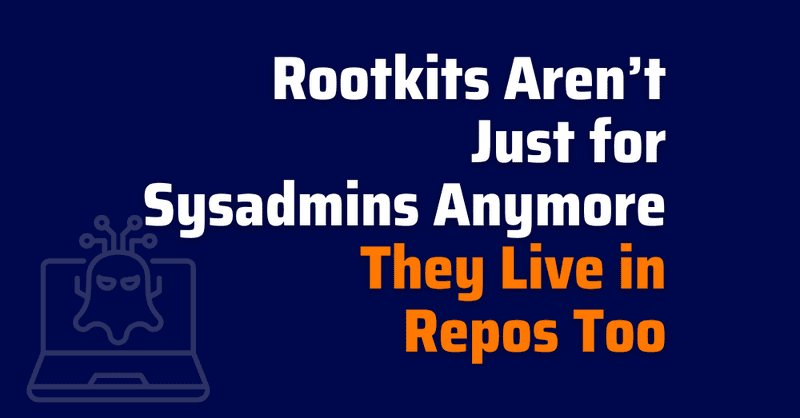What Is a Rootkit?
A rootkit isn’t just low‑level malware anymore. At its core, it is stealthy malware that gives unauthorized access while hiding its own existence. In traditional contexts, rootkits live in kernel space or system services. However, today, they also reside in your repositories, CI systems, and package manifests, hiding in plain sight, tampering with code integrity, and infecting build systems.
From System Rootkits to Repository Rootkits
System engineers used to sweat over kernel rootkits. These gave full control over a system, intercepting syscalls, hiding processes, and keeping code integrity compromised. Now, assume a developer‑centric scenario: a malicious actor injects a rootkit into your Git repo or dependency tree. This repository rootkit is code that manipulates your build outputs or sneaks in backdoors, becoming part of your package artifacts, even before a system ever runs them. Rootkits shift upstream into your source, dependencies, and CI/CD flows.
How Rootkits Hide in Codebases and Dependencies
Let’s unpack tangible rootkit attack vectors developers must watch:
- Obfuscated or misleading commits
Imagine a commit that says “fix typo” but actually injects a loader that decrypts malicious payloads at runtime. Rootkit detection is tricky when commit messages hide intent. - Altered or backdoored libraries
A common utility function gets replaced with a subtly backdoored version. It passes tests but logs secrets to a remote server after hours. Code integrity is broken, even though the library looks familiar. - Compromised third‑party packages and transitive dependencies
You installed lib-crypto@2.0.1; upstream, someone poisoned version 2.0.0 with malware. Now your pipeline pulls a rootkit by accident, or worse, your lockfile got drifted and you pulled the tainted code. - Sleeping code and logic bombs
Code sits benign for weeks or months, then wakes up. For example:
if os.getenv("DEPLOY_DATE") == "2025-09-01":
execute_backdoor()
Tests pass today, and you don’t notice code integrity failing until it’s too late.
Why Rootkit Detection Matters in DevOps
Rootkits in your pipeline and repos threaten real developer workflows:
- Tampered builds that pass unnoticed: If a rootkit hooks into your build script, say a malicious post install or setup.py, your CI will pass, and you push compromised artifacts without knowing.
- Inconsistent or non‑reproducible builds: A rootkit might cause builds to differ on developer machines vs CI agents. That difference is a red flag for code integrity, but only if you’re checking for it.
- Persistent compromise across releases: Once embedded, it can survive branch merges, cherry‑picks, and future releases. Worse, it might inject itself into updates, corrupting your supply chain.
- Pipeline poisoning and lateral movement inside developer environments: A rootkit can spread through CI configs, shared runners, and developer machines with shared credentials. Code integrity is breached not just in code, but across environments.
Practical Rootkit Detection in Pipelines
Here are developer‑friendly, actionable techniques to raise your rootkit detection game:
• Hash validation for critical files and dependencies
Compute a SHA‑256 (or similar) for key files such as requirements.txt, package-lock.json, or top-level build scripts:
sha256sum requirements.txt > baseline.hash
...
sha256sum -c baseline.hash
Any change to those files signals potential malicious drift.
• SBOM (Software Bill of Materials) validation
Generate SBOM with tools like Syft or SPDX. Track exactly which dependencies (and versions) are in your build. Compare SBOMs across builds to detect unexpected or malicious additions.
• Signed commits and signature verification
Enforce git commit -S and check signatures in CI:
git verify-commit HEAD
A new, unsigned, or suspiciously signed commit could be a source-rootkit probe.
• Behavior‑based anomaly detection during build or runtime
Instrument your build with profiling to catch odd behavior: for example, unexpected network calls during npm install or pip install, or file changes in protected dirs:
# in CI pipeline
strace -f -e trace=network python setup.py install
Unexpected outbound traffic during install may be a rootkit loading stage.
• Scanning for obfuscated or high‑entropy code segments
Use tools that flag suspicious code entropy or non‑ASCII/hard‑to‑read sections in pull requests. For example, integrate a scan for Base64 blobs or weird exec/eval usage. Highlighted code might be a sleeping loader or an encrypted payload.
Maintaining Code Integrity Across the Supply Chain
Long‑term, you need practices that make rootkit detection second nature:
- Dependency pinning and lockfiles: Always commit lockfiles (package-lock.json, requirements.lock, etc.). Pin versions so you don’t accidentally pull mutated transitive dependencies and risk a rootkit slipping in.
- Cryptographic signing of releases and packages: Sign your own build artifacts with GPG or similar. Consumers verify signatures; if a rootkit tampered with your release, verification fails and breaks the chain of trust.
- Regular review of third‑party and transitive changes: Use dependency‑monitoring tools that flag new or changed dependencies. Combine with SBOM diffs to detect injected or replaced modules.
- Continuous monitoring for dependency drift or unauthorized changes: Automate SBOM diffs in your CI: fail builds if unexpected dependencies appear. Track dependency drift over time, and alert if something deviates from the expected state: e.g., a rootkit commit or replaced dependency.
Conclusion
Rootkits aren’t confined to sysadmins and kernels anymore; they’ve migrated into the heart of development: your repos, builds, and CI pipelines. Developers must treat rootkit detection and code integrity as core appsec concerns. By using hash validation, SBOM auditing, signed commits, behavior anomaly detection, and dependency hygiene, you build practical defenses against rootkits living in code.
A tool like Xygeni, focused on software supply‑chain hardening, can empower DevSecOps teams to maintain code integrity and detect rootkit threats early in the workflow. It’s a vital ally for developer‑first security, helping stop this before they spread through your repo, build, or production.
